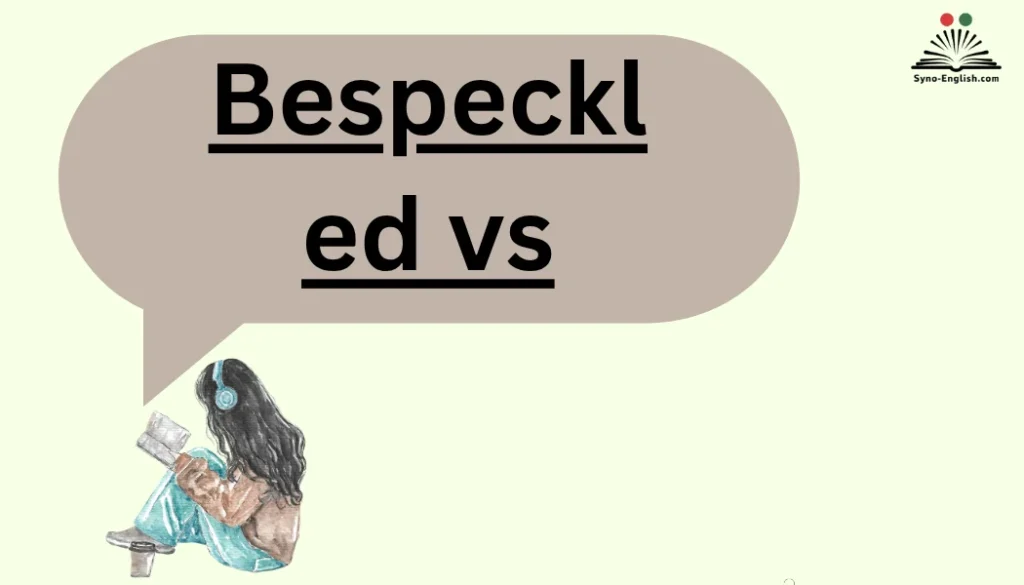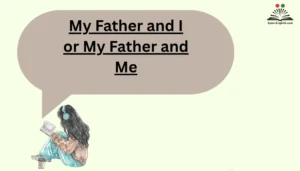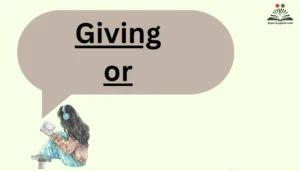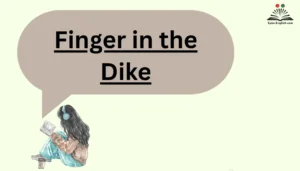The language we use every day is full of words that sound similar but have different meanings, and one confusing pair is bespeckled vs. bespectacled, which often puzzles both writers and readers (147 characters). At first glance, these terms seem like twins—they both start with bes- and end with -led—yet they describe very distinct ideas.
Bespeckled describes something covered in spots, while bespectacled refers to a person wearing glasses. The difference might appear small, but in careful expression and precision, it matters greatly.This articleexplores the origins of both terms and shares practical tools to remember and use them confidently.
When I first learned about these, I pictured a painter’s shirt covered in spots to recall bespeckled, and a person putting on glasses to recall bespectacled. Over time, this simple trick made it easier to notice the rightchoice in any sentence. The key is to pause, observe, and allow your understanding of language to deepen naturally.
Understanding the Meaning of “Bespeckled”
Definition and Meaning
The word bespeckled means covered with or marked by specks, spots, or small patches. It paints a picture of something dotted or scattered with marks. You might describe a bird’s egg as bespeckled with brown flecks or a shirt stained with tiny drops of paint as bespeckled.
Etymology
“Bespeckled” comes from the root word speckle, meaning a small spot or fleck. Adding the prefix “be-” gives the sense of being thoroughly or abundantly marked. Linguists trace “speck” back to Middle English and Germanic roots, connected to words like spicke or speck, meaning a particle or small piece.
In short, bespeckled is not a modern invention but a natural evolution of descriptive English.
Grammatical Role
“Bespeckled” is an adjective. It modifies nouns by adding detail to their appearance. For example:
- A bespeckled notebook lay forgotten on the desk.
- Her bespeckled apron revealed the chaos of cooking.
The word often has a visual emphasis, helping readers imagine texture or surface patterns.
Examples in Sentences
- The bespeckled robin hopped across the garden wall.
- He wore a bespeckled shirt that looked like it survived an art class explosion.
- A bespeckled moon hung in the night sky, scattered with dark craters.
Literary and Historical Usage
Writers have long used “bespeckled” to create vivid imagery. For instance:
- In nature writing, it often describes animals—a bespeckled trout shimmering in the stream.
- In poetry, it adds detail and rhythm—her cheeks, bespeckled by freckles of dawn.
It’s less common in modern journalism but still valuable in creative and descriptive writing.
Understanding the Meaning of “Bespectacled”
Definition and Meaning
The word bespectacled means wearing spectacles (glasses). It’s often used in character descriptions, especially in literature or journalism. Think of the classic phrase: the bespectacled professor at the lectern.
It doesn’t refer to the glasses themselves but to the person wearing them.
Etymology
“Bespectacled” is formed from the word spectacle—which originally meant “glasses” before taking on broader meanings like “a grand display.” The suffix “-ed” indicates possession or condition. Combined with the prefix “be-”, the word essentially means “equipped with spectacles.”
This usage became popular in the 19th century, when glasses became more common and socially accepted.
Grammatical Role
Like bespeckled, bespectacled is an adjective. It describes people, typically focusing on their appearance:
- The bespectacled librarian scanned the room silently.
- He was a bespectacled teenager, buried in books.
Examples in Sentences
- A bespectacled man waved from across the platform.
- The bespectacled scientist adjusted her frames before answering.
- Reporters often described him as a bespectacled statesman.
Cultural and Literary Usage
This word appears frequently in character sketches. From Sherlock Holmes’ bespectacled associates to modern journalists, it signals intellect, studiousness, or eccentricity. Sometimes it carries stereotypes—the bespectacled nerd—but it can also simply be neutral description.
Key Differences Between “Bespeckled” and “Bespectacled”
Although they look alike, these words belong to very different worlds. Here’s a quick comparison:
| Feature | Bespeckled | Bespectacled |
| Meaning | Covered with spots, specks, or marks | Wearing spectacles (glasses) |
| Root Word | Speckle (spot) | Spectacle (glasses) |
| Part of Speech | Adjective | Adjective |
| Usage Context | Surfaces, objects, animals, skin | People, characters, portraits |
| Example | A bespeckled bird sat on the fence | The bespectacled teacher smiled kindly |
Visual Mnemonic:
- Speck in bespeckled → specks or spots.
- Spectacle in bespectacled → spectacles or glasses.
Common Misconceptions
People mix up these words because they:
- Look almost identical in structure.
- Both start with “bes-” and end in “-led.”
- Appear in similar contexts in descriptive writing.
A frequent mistake is writing bespeckled professor when the intended meaning is bespectacled professor. One refers to spots, the other to eyewear.
Real-world examples show this confusion:
- Online forums sometimes feature misused versions, like the bespeckled historian lectured for hours. Unless the historian was covered in spots, this is a misuse.
Correct Usage and Guidelines
When to Use “Bespeckled”
- Describing surfaces, patterns, or appearances with dots or specks.
- Common with clothing, skin, animal patterns, or natural objects.
Examples:
- The child’s bespeckled face glowed with freckles.
- A bespeckled canvas leaned against the studio wall.
When to Use “Bespectacled”
- Describing a person who wears glasses.
- Often appears in character sketches or journalistic writing.
Examples:
- A bespectacled clerk processed the forms quickly.
- The bespectacled author signed copies of her book.
Tips to Remember the Difference
Memory Tricks
- Speck = spots. If you see specks, think bespeckled.
- Spectacle = glasses. If someone wears spectacles, they’re bespectacled.
Visual Mnemonics
Imagine this scene:
- A bespeckled egg lying on a nest.
- A bespectacled owl reading a book through glasses.
Short Rhymes
- Bespeckled with dots, bespectacled with glasses
Related Words and Synonyms
While bespeckled and bespectacled are unique, there are useful synonyms:
For Bespeckled:
- Spotted
Flecked - Dappled
Mottled
For Bespecacled:
- Glasses-wearing
- Eyeglass-wearing
- Goggle-eyed (colloquial, not exact)
Keep in mind, synonyms don’t always carry the same nuance. For instance, “mottled” implies irreguar color patches, not just specks.
Case Study: The Professor Mix-Up
Consider this:
A journalist once described a university dean as “the bespeckled professor addressing the hall.” The image that comes to mind is a professor covered in paint flecks—not the intended meaning. The correct word was bespectacled.
This mistake caused laughter among readers and highlighted how small spelling differences can shift meaning drastically. Accuracy in word choice protects credibility
Conclusion
Understanding the difference between bespeckled and bespectacled goes beyond memorizing vocabulary—it’s about developing a deeper awareness of how language shapes expression. Both words may share a similar rhythm and appearance, starting with bes- and ending in -led, yet they point to very different realities. Bespeckled paints a visual of something covered in spots, while bespectacled identifies a person wearing glasses. Recognizing such nuances empowers writers and readers to communicate with precision, ensuring their thoughts are conveyed exactly as intended. When we pause to analyze words like these, we learn not just their meanings but the importance of detail in effective communication.
With time and practice, you’ll find that choosing between bespeckled and bespectacled becomes second nature. This mastery builds confidence, helping you spot the right word without hesitation. It’s a skill that enhances your grammar, strengthens your observation, and refines your creative thinking. Whether you’re writing academically, professionally, or casually, the ability to make fine linguistic distinctions is invaluable. The beauty of the English language lies in its depth, and understanding pairs like these encourages us to respect that complexity. So, the next time you come across a pair of look-alike words, take a moment to explore their origins—because every term tells a story worth discovering.
FAQs
What does “bespeckled” mean?
“Bespeckled” means something that is covered in small spots or marks. For example, a bird with spotted feathers or a shirt with paint drops can be described as bespeckled.
What does “bespectacled” mean?
“Bespectacled” refers to a person who wears glasses. It’s often used to describe someone’s appearance, such as “a bespectacled professor.”
Why are “bespeckled” and “bespectacled” confusing?
They sound and look similar because both start with bes- and end with -led, but they describe very different meanings.
How can I remember the difference easily?
Think “speck” for spots and “spectacles” for glasses—that’s the simplest way to remember.
Are both words adjectives?
Yes, both bespeckled and bespectacled function as adjectives, describing appearance or condition.
Is “bespeckled” used often today?
It’s less common but still used in literature or descriptive writing to add color and imagery.
Can “bespectacled” describe things other than people?
Usually no—it’s reserved for people because it literally refers to wearing spectacles.
Do the words share the same origin?
Both use the prefix bes-, meaning “around” or “about,” but their roots differ—“speck” (spots) and “spectacle” (glasses).
Are there similar confusing word pairs?
Yes—examples include affect vs. effect, imply vs. infer, and complement vs. compliment.
Why is it important to know the difference?
Knowing the right usage improves clarity, builds credibility, and enhances your language skills, making communication more precise.

Emma Brooke is a passionate English educator, writer, and language enthusiast with over a decade of experience helping learners master the nuances of the English language. At SynoEnglish, she blends practical grammar advice with real-world communication tips to make English easier, clearer, and more enjoyable for readers of all levels.



